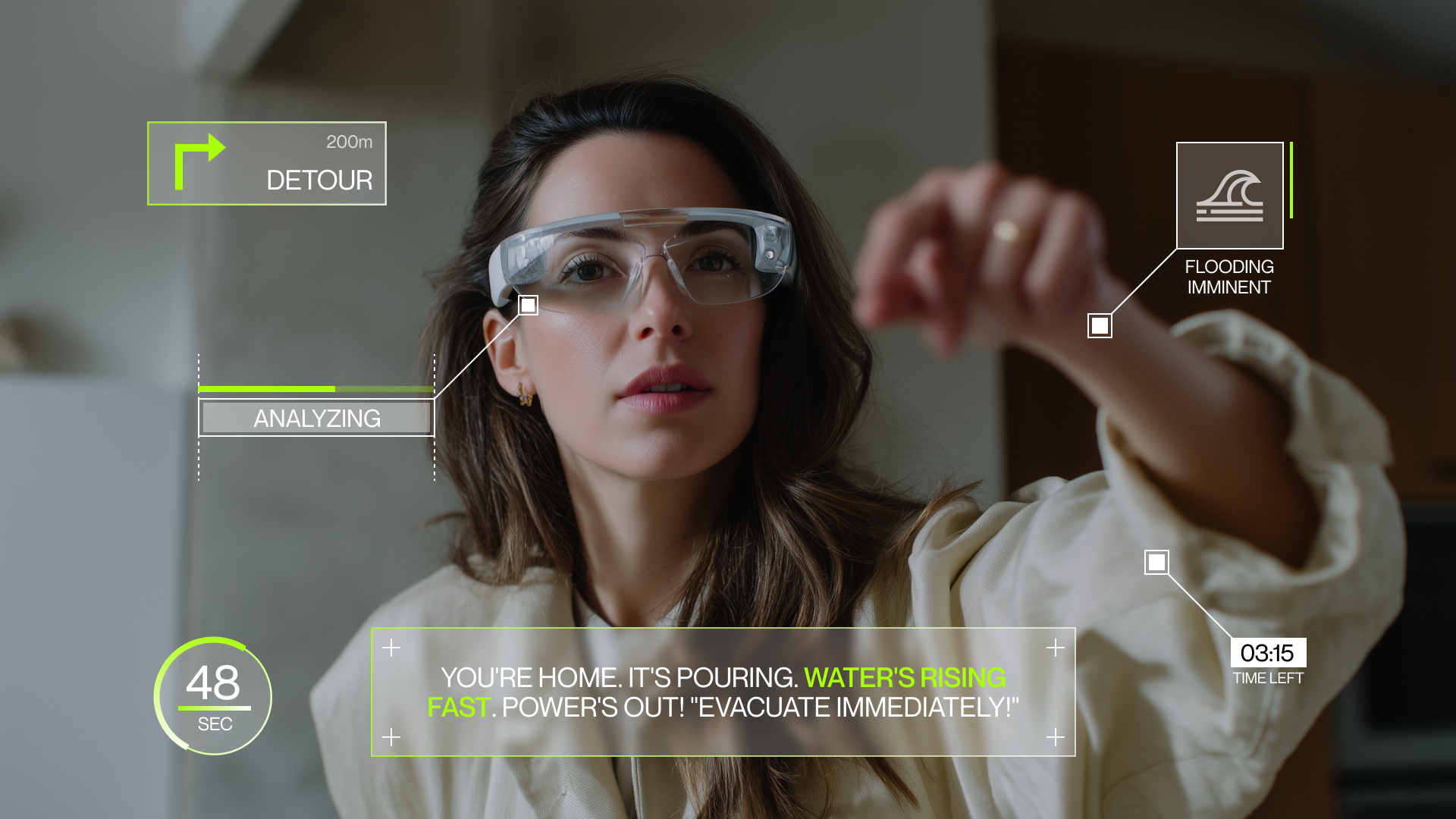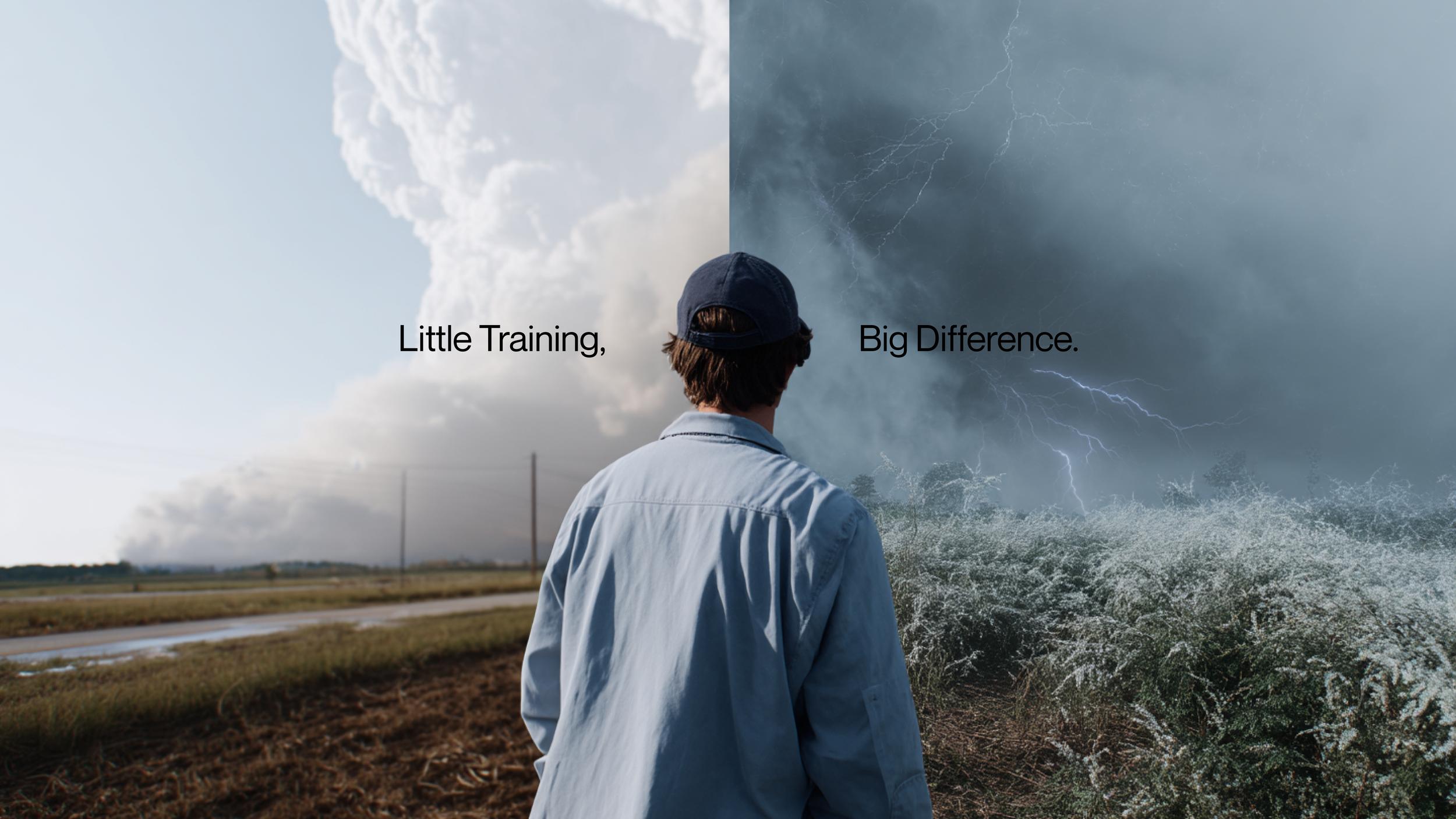
HAVEN
/Overview
The Extreme Weather Survival Trainer AR glasses, paired with an app, transform emergency preparedness into an interactive, hands-free experience. By combining AI, real-time environmental data, and AR simulations, the glasses allow users to train, react, and make decisions as if they were inside an actual disaster scenario.
/Context
- UX/UI Project
- Solo Project
- Duration : 12 Weeks
/Instructor
- Sally Chung
- Jen Choi

Problem Statement
“Low Preparedness”
Despite increasing awareness of extreme weather events,
low preparedness among individuals remains a critical issue, significantly heightening their risk and vulnerability during disasters.

(1)
Ideation
[Research]
Recently, California has been battling severe wildfires, with 8,024 fires recorded in 2024, burning over 1 million acres and destroying 1,716 structures, resulting in 1 fatality. In early 2025, another wildfire in Los Angeles caused at least 29 deaths, destroyed 17,000 buildings, and displaced thousands of people.
Background
49%
Despite living in areas at higher risk of wildfires, only 49% of people in these regions perceived themselves to be at significant risk. This low level of risk perception can hinder preparedness actions.
Low Risk Perception
Lack of Preparedness Actions
57%
While 57% of Americans took three or more actions to prepare for a disaster in 2023, those living in high-risk wildfire areas had lower preparedness rates compared to other areas. Emergency managers need to use effective risk communication to raise awareness and motivate action in these communities.
Ideation
(2)
[Hypothesis]
Hypothesis
If individuals who are unfamiliar with disasters receive immersive, hands-on training through simulated real-life scenarios, they will develop the skills necessary to respond effectively, thereby improving their preparedness and safety during extreme weather events.
Target User
Individuals who are unfamiliar with disaster preparedness but are vulnerable to unexpected climate emergencies.
How Might We
How might we use immersive AR glasses connected to an app to enhance disaster preparedness and equip vulnerable individuals with the skills and confidence needed to respond effectively to extreme weather emergencies?


(3)
[Key Features]
Key Features
Personalized Risk Assessment:
Research
Real-time Environmental
Data Integration:
The app syncs with the AR glasses to deliver live data on local weather conditions, alerts, and updates to keep users informed during training and in real-world situations.
The app analyzes users' location, lifestyle, and historical data to provide a personalized risk profile, offering tailored training simulations based on potential threats in their area (e.g., wildfires, floods, heatwaves).
Interactive, Real-time Simulations
for Training:
The glasses provide users with immersive disaster scenarios to practice decision-making and survival skills in real-time.

(3)
[Survey]
Key Questions
Research
Are you familiar with concept of disaster preparedness?
Have you ever worried about being caught in the middle of an extreme weather event?
What preparations or actions would help you feel secure in an extreme weather event?
Zero
Respondents answered “Yes”
70%
occasionally worry about extreme weather events.
80%
Feel more secure with real-time weather updates, alerts, and better knowledge of emergency procedures.

(4)
[Problem Statement]
Pain Points
Discover
A lack of risk awareness (psychological factor)
Lack of knowledge on how to respond to disasters
Limited access to detailed real-time disaster updates
Solutions
Risk Assessment & Behavioral Reinforcement
Guided, Scenario-Based Training
AI-Powered Alerts & Live Risk Monitoring
Define
(2)
[Persona]
Sarah
Software Engineer (Working from Home)
“Recent wildfires made me realize
I need to be better prepared for my kids and me, with a tool that shows how to respond in an emergency and teach them to stay safe.”
Frustrations
Goals
Married, Two Kids
Overwhelmed by disaster preparedness: Finds emergency planning confusing and doesn’t know where to start.
Difficulty teaching kids about emergencies: Struggles with how to explain disaster preparedness in a simple, age-appropriate way.
Theoretical advice with no practical application: Seen guides, but none of them feel relevant or easy to apply to daily life.
Prepare for climate-related emergencies to ensure her family’s safety.
Teach her kids essential survival skills and how to respond during a disaster.
Feel confident and organized in emergency situations, knowing exactly what steps to take.
Persona
Define
(2)
[Empathy Map]

(1)
[Usability Testing]
Goal
To understand how users interact with disaster preparedness training, identify their focus areas, and determine their preferred training methods to improve the app's usability and effectiveness.
Mission
-
Observe how users navigate through the disaster preparedness features, focusing on ease of use and intuitive design.
-
Gather feedback on which training methods users find most effective and engaging for learning about disaster preparedness.
-
Find out which parts of disaster preparedness (like specific emergencies, survival tips, or action steps) users care about the most and use the most, making sure the app fits their needs.
Insights after Usability Testing
Develop
(2)
[Design iteration]
Home Page
It's difficult to see the necessity of the Current Weather section; focusing on survival training itself is more important.
Profile
The profile lacks a user introduction, self-simulation space, and visual progress tracking, and without rewards, staying motivated may be challenging, especially with a serious design
Solutions :
(a)
(b)
Visually showcase user progression and achievements.
Include a reward system to boost user engagement.
Training Mode
The alert screen could obstruct visibility, and long text might distract from training. A purely training-focused approach or an overly entertainment-driven game format could reduce engagement and effectiveness.
Solutions :
Solutions :
(a)
(b)
(a)
Focus more on user progression, achievements, and include a personalized training mode for a tailored experience.
(b)
Provide weather-related disaster information.
Use simple gamification elements to maintain clarity and effectiveness.
Provide detailed scenarios and allow users to expand their training locations by analyzing their location patterns or customizing settings.
(1)
[Design System]
Design Principal
HAVEN blends realism, clarity, and motivation to create immersive AR training that feels personal and purposeful, helping everyone prepare for emergencies with confidence.
-
Provide realistic AR experiences that feel like real-life training, while ensuring every moment has a clear educational goal.
-
Motivate users through visible progress, achievements, and a reward system that keeps them engaged and driven.
-
Deliver essential information quickly and clearly, minimizing visual distractions during high-stress situations.
-
Offer training scenarios tailored to each user’s location, habits, and potential risks for more relevant and effective learning.
-
Design game elements to be simple and intuitive - enhancing engagement without compromising realism or learning effectiveness.

Ideation
(2)
[Brand Mission]
Mission
HAVEN empowers individuals to prepare for climate emergencies through immersive, personalized AR training—turning small steps into confident action when it matters most.
(4)
[Conclusion & Takeaways]
5.16
Times
Conclusion
“Recent access to disaster preparedness information increases a household’s likelihood of being well-prepared by 5.16 times.”
— Natural Hazards and Earth System Sciences (NHESS)









